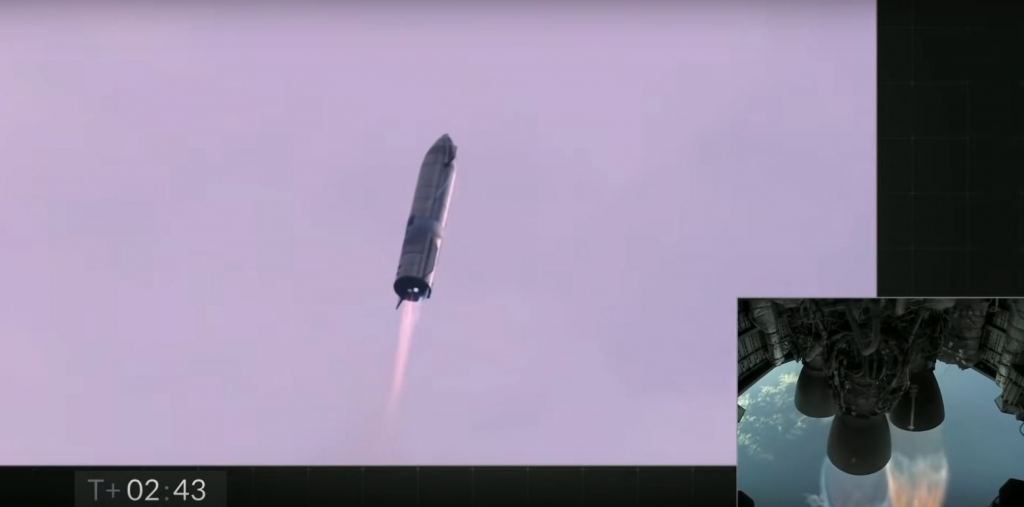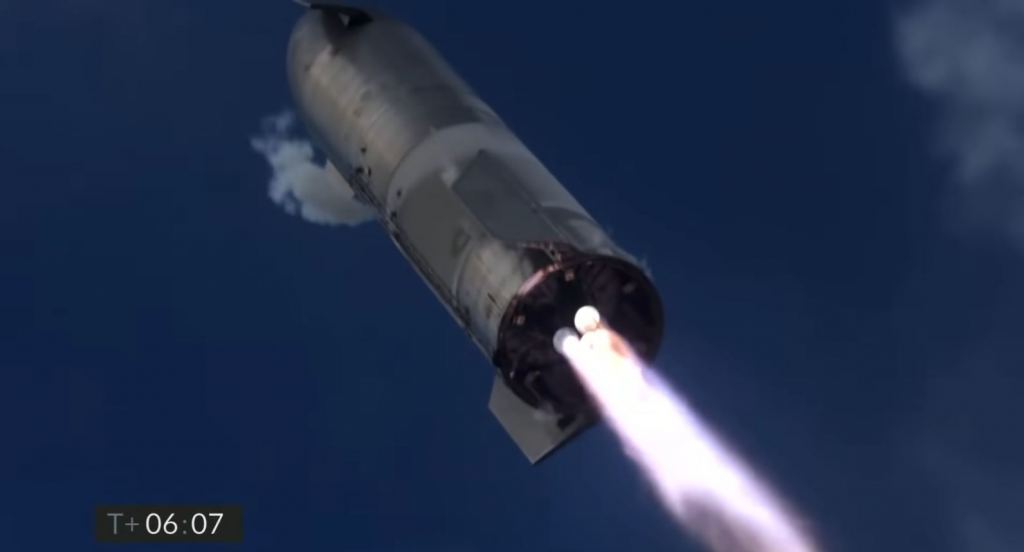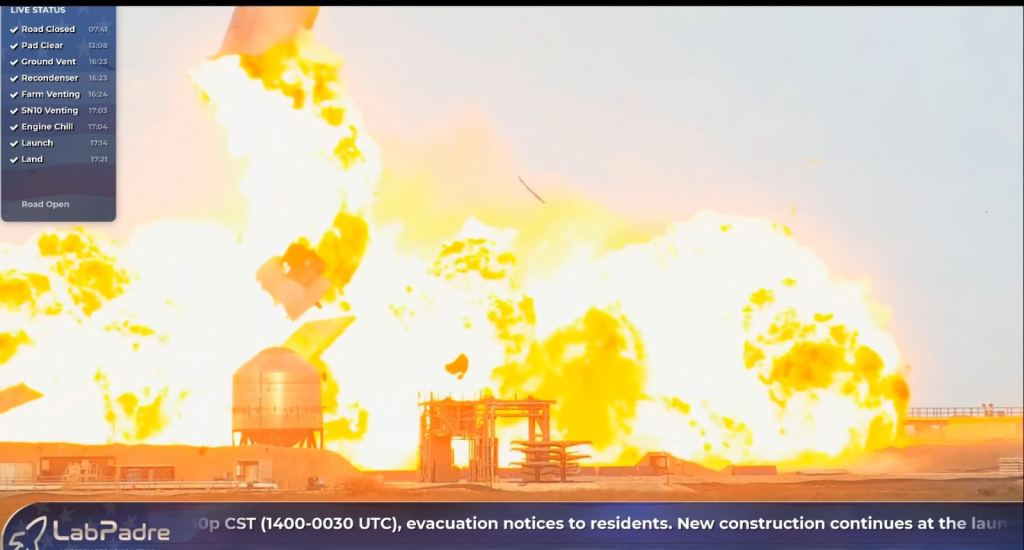Fantastic Analysis of SN-10 Landing and Explosion by @DJSnM
By Matt Williams
On March 3rd, 2021, SpaceX conducted a third high-altitude flight test with one of their Starship prototypes (SN10). This time around, the prototype managed to achieve an apogee of 10 km (6.2 mi), a controlled descent relying on nothing but its aerodynamic surfaces (the “belly-flop”), and even managed to land successfully. However, a few minutes after it stuck the landing, the SN10 exploded on the landing pad.
Whereas the SN8 and SN9 explosions were attributed to problems that took place during engine reignition, the cause of the SN10 explosion was not as clear. Thankfully, astrophysicist and Youtube personality Scott Manley (Twitter handle @DJSnM) has offered his take on what might have caused it. Using SpaceX’s footage of the SN10 flight test, he suggests that a slightly-harder-than-intended landing and a fuel tank rupture were responsible.
In the video, shown above, Manley starts with an observation regarding the engine flame, where one appeared to be burning hotter than the others. This became evident later in the flight when the SN10 was running on two engines, one of which was emitting a flame that was more orange than the other. This, according to Manley, could be interpreted as a sign that it was burning more fuel (aka. “fuel-rich”).
He attributed this possibility to the first launch attempt the ground crews made at 09:00 AM CST (07:00 A.M. PST; 10:00 A.M. EST). This resulted in an engine abort, where the SN10‘s automated systems shut the engines down because the thrust limit (which was set conservatively) was exceeded. In response, the ground crews reset the thrust limit and made a second attempt at 05:14:45 P.M. CST (03:14:45 P.M. PST, 06:14:45 P.M. EST.
After that, the flight continued without incident and the SN10 achieved its maximum altitude roughly 4 minutes and 20 seconds into the flight. The prototype proceeded to successfully hover, shut all three engines down, flip its fuselage around, and make a controlled descent using just its fins and aerodynamics surfaces. It was at this juncture, when the engines reignited and the prototype landed, that Manley pointed to another issue.
For this test, ground crews were really hoping to demonstrate that the prototype was capable of landing since the previous two prototypes exploded while touching down. For this reason, they decided to mix things up a bit by igniting all three engines at once, then two shut down very quickly, leaving only one to bring the prototype in for a landing.
A few minutes later, after SpaceX had already wrapped up its live coverage, the prototype exploded, leaving many who were still watching to ask “what just happened?!” As Manley demonstrated by comparing the SpaceX and footage collected by LadPadre, the landing was a bit rough. This was evident from the speed at which it touched down and the small bounce that was discernible once it did.

When the other two Raptor engines shut down, the one that remained lit appeared to be dumping a lot of methane too (as evidenced by the flame ups around the skirt). To this, Manley offers a theory:
“I think there may be a stuck valve at this point because – of course – after the heavy landing, there was enough stuff burning on the ground that they needed to employ the water deluge system to help control the situation. So that fire was coming from one of the ground service pipes… You can see that it’s shooting down initially and generating that cryogenic white cloud of very cold gas. And over time, that flame burns down into it.”
In short, Manley believes that the main issue at this point was with the plumbing that is responsible for loading the rocket with methane fuel (aka. the vehicle fuel system). In short, he stresses that it was not an engine issue that caused the flame up to occur once the SN10 was on the ground. Looking closely at the footage, Manley also identified an issue with the landing legs.
As the SN10 lowers itself to the pad, three of its legs deployed and locked in place while the others appear to swivel in and out of position without locking. This is why, Manley claims, the Starship appeared to be leaning after it landed and could have caused structural damage that contributed to what followed:
“These legs are a temporary solution. They are designed to get crushed by the force of the impact, absorbing the energy. And of course, having only three of them instead of six means there’s a lot less crush to go around, and that probably contributed to having a lot more force applied to the body. When the smoke cleared, this was very much the ‘Leaning Tower of Starship.’ It had collapsed on the rear without any of the legs being visible. There was no space between the skirt and the ground.“

Using footage from LabPadre and NASASpaceflight, Manley was also able to deconstruct the explosion to show what happened. It started with a small puff of smoke coming out of the engine vents, followed by the vehicle’s main oxygen tank splitting in two and releasing a tremendous amount of pressure. Shortly thereafter, the header tank bursts as well, releasing additional pressure.
From this, Manley concludes that it was these releases that caused the Starship to “jump” from the landing pad. This is similar to what happened during several of the cryogenic load tests with previous prototypes, where the force of their ruptured tanks caused the fuselage to “jump.” The resulting release of cryogenic oxygen and methane, plus the methane coming from the fuel system, was ignited by the existing fire.
“There’s enough pressure in those tanks that when the tank fails, that is entirely responsible for pushing the vehicle upwards and causing its destruction,” said Manley. “The fire is sort of an incidental effect, in this case. It may make the launch a little more aggressive, but a tank failure like that would send the vehicle upwards and would send the vehicle up on its own.”
Further indications are the way the explosion was asymmetrical – i.e., it happened more on one side – which is why the fuselage flipped over in the air. The way the fuselage was completely flattened by the time it hit the ground suggests that the bulkhead between the main methane and main oxygen tank had failed. Otherwise, he claims, “there would have been some sort of gas pressure in there and the thing would have gone sideways.”

To summarize, Manley asserts that the explosion was the result of structural damage caused by a harder than normal landing, caused by an issue with one of the Raptor engines and the failure of three landing legs. This caused a small fire to break out upon landing, followed by the fuel tanks rupturing, which sent the fuselage flying while creating a fireball beneath it. In short, it was “pressure-driven,” not an internal explosion.
This sort of analysis is not unlike what engineers at SpaceX are doing right now, which is sorting through all the mission data to ascertain the causes (or causes) of the explosion. Naturally, the SpaceX team has a lot more than just video footage to go on, but the principle is the same. As always, it’s test to failure, learn, and repeat. It’s only once we’ve finished with all that that we can “launch, recover, repeat.”
The post Fantastic Analysis of SN-10 Landing and Explosion by @DJSnM appeared first on Universe Today.

March 11, 2021 at 04:33AM
via Universe Today read more...

Post a Comment